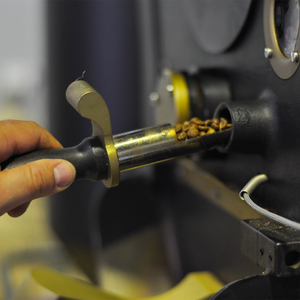Roastery
The journey of an amazing cup of coffee from crop to cup is nothing short of a miracle, considering all that can go awry during the process. Each picked cherry produces just two coffee beans. You can imagine how many picked cherries are necessary for just one cup of coffee. Once the beans are dried and processed, they are bagged and shipped from their country of origin.
Coffee grows in the coffee belt, the region between the Tropics of Cancer and the Tropics of Capricorn, just north and south of the equator. Coffee needs the intense heat of the tropics and the long days of sunlight to yield its fruit by day, however, the evening tells a very different story. Elevation at which a particular coffee grows affects its density. The higher the elevation of growing coffee, the colder the night time temperatures. This yields slower growth and a higher density or a more tightly packed cell structure.
Why is this important? Well these bits of information provide the roaster with pertinent information for formulating a plan to roast each particular bean. Before roasting, green coffee beans are soft, with a grass like smell and little to no taste. The coffee roasting process transforms these raw beans into the distinctively aromatic, flavorful, crunchy beans that we recognize as coffee.
The degree to which coffee beans are roasted is often times considered one of the most important factors in determining the taste of coffee in the cup. However, this could not be further from the truth. Latitude, elevation, originating country, region, and pollinating crops in the area all make a considerable difference in the eventual taste of coffee. With all these variables in mind, each coffee must journey through the roasting process in its own way in order to realize its very best flavor and aroma to accentuate each bean’s optimal attributes in the cup.
Each bean often times tells you how it wants to be roasted in the way that it absorbs heat, resists heat, and by the amount of heat necessary to break down the inner structure of the bean as it travels from phase to phase. Coffee journeys through the drying phase where it releases its moisture. This leads it to the Milliard phase where the sugars begin to caramelize. Once the beans have absorbed all the heat they can handle, they reach their breaking point and begin to crack – marking the point of no longer absorbing heat, but giving off heat. At this point, the longer the coffee roasts and the higher the temperature to which the coffee is exposed, the darker the color. In general, the faster the coffee roasts and the lighter the color, the more bright and acidic the coffee will be.
Conversely, the longer the coffee develops during the roast, the sweeter and less acidic the coffee becomes. The most common way to describe a coffee roast is by the color of the roasted beans, ranging from light to dark (or extra dark). Oils appear on the surface of the beans at higher temperatures. Because coffee beans vary, color is not an especially accurate way of judging a roast. But combined with the typical roasting temperature that yields a particular shade of brown, color is a convenient way to categorize roasting levels.
The freshly roasted coffee that we sell really is a labor of love. We only accept the highest quality beans and then artfully roast them to their peak perfection, accentuating the beauty of their aroma and flavor. Every step of the roasting process is important here at Special Grounds Coffee Co. and we take it very seriously.
We take great pride in the coffee we produce and we distribute our gourmet roasts and proprietary blends to individuals, businesses and churches around the country. If you are a business, church or other large organization desiring gourmet coffee, click HERE to contact us for volume based pricing and information.

Quality is Our Obsession
We know you can go anywhere and get a cup of coffee. That's why we're obsessed with bringing you the best tasting coffee you can find!

Keeping it Fresh
The key to great tasting coffee is freshness. We small batch roast to order so we can get coffee into your mug as fresh as possible.
